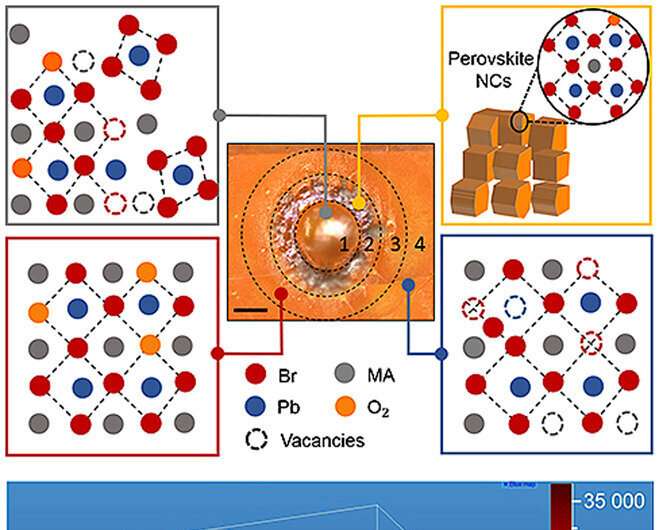This article has been reviewed according to Science X's editorial process and policies. Editors have highlighted the following attributes while ensuring the content's credibility:
fact-checked
trusted source
proofread
Femtosecond laser ablation of crystalline perovskites induces space-resolved light emitting and lasing behaviors

Recently, researchers from the Changchun Institute of Optics, Fine Mechanics and Physics of the Chinese Academy of Sciences published a study in Materials Today Physics that sheds light on the light emitting properties of perovskite materials after being subjected to femtosecond laser processing.
Lead halide perovskites have become popular because of their excellent photovoltaic effect, and for creating interesting micro/nano light emitting structures. However, there has been a lack of insight on how high intense laser induced morphology and defect chemistry can affect light emission.
In the study, the researchers found that the space-resolved photoluminescence (PL) and lasing behavior for both single crystal and polycrystalline MAPbBr3 perovskites were significantly impacted by the femtosecond laser ablation.
The femtosecond laser induced regions of the material were found to possess different light emitting behaviors with respect to the unaffected surface area due to their distinguished defect chemistries and morphologic profiles. The space resolved steady-state and time resolved PL studies along with the scanning electron microscope images reveal that the laser affected and unaffected regions comprise distinguishable carrier recombination mechanisms.
For the single crystal perovskite samples, the recast deposition region was found to exhibit amplified spontaneous emission (ASE) through the multiple scattering of light by the recrystallized micro/nanostructures. The biexciton mechanism was identified as the major gain mechanism that causes the ASE effect.
The laser modified region on the polycrystalline perovskite sample revealed a significant enhancement of random lasing (RL) performance. The results confirms that the emission belongs to the incoherent RL emission due to the long mean free path length of scattering light. It was further demonstrated that laser induced non-radiative defect passivation and reduction of average crystalline grain sizes could significantly enhance incoherent RL emission properties. The RL threshold was reduced by almost seven times and the slope efficiency increased by 1.5 times.
This study reveals the physical and chemical modification effects of the femtosecond laser irradiation on perovskite materials and suggests that it is an optimal strategy to fabricate desired perovskite light-emitting microstructures by ultrafast laser processing.
More information: Rahul A. Rajan et al, Space-resolved light emitting and lasing behaviors of crystalline perovskites upon femtosecond laser ablation, Materials Today Physics (2023). DOI: 10.1016/j.mtphys.2023.101000
Provided by Chinese Academy of Sciences



















